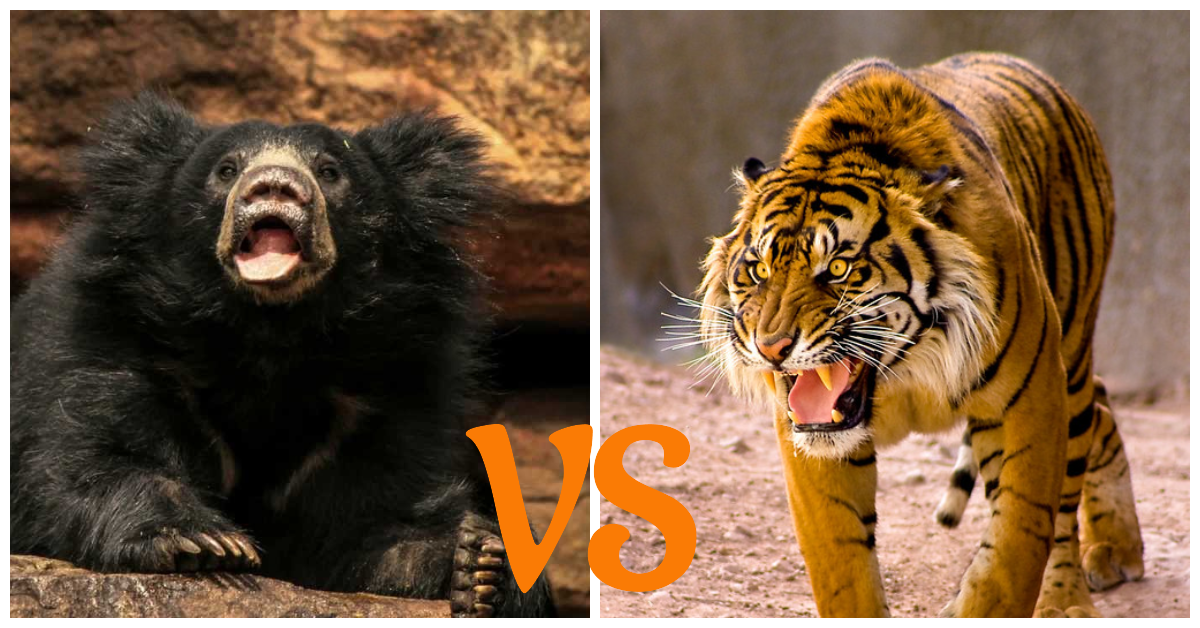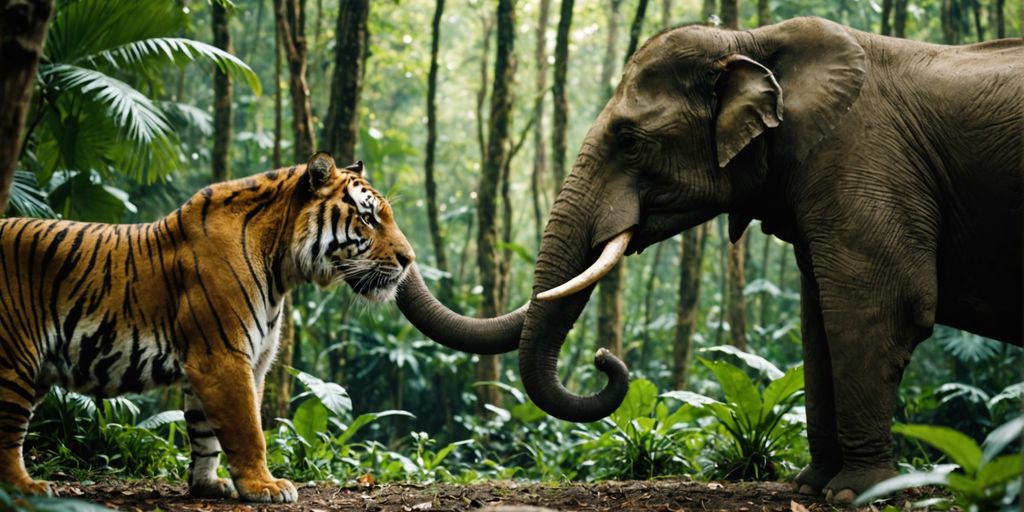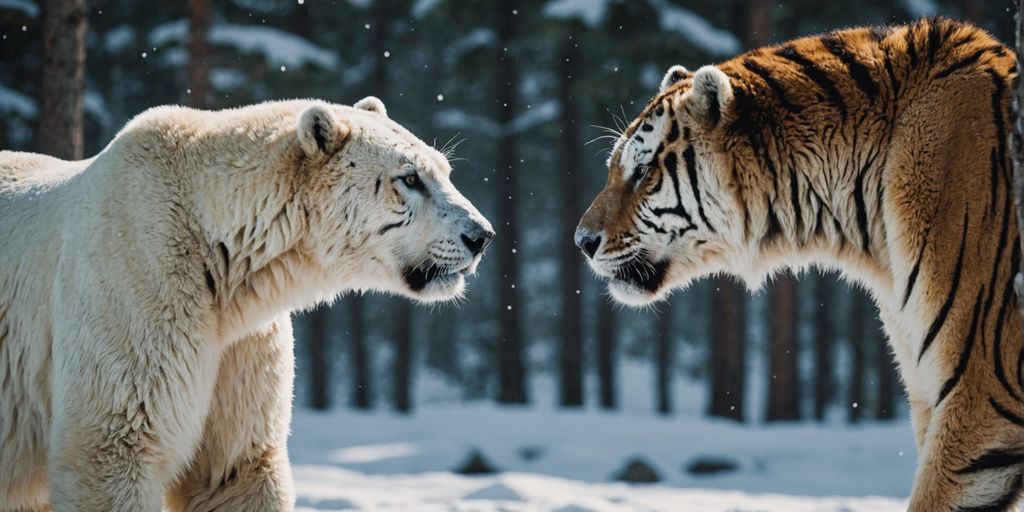Your Cart is Empty
🙏HELP US SAVE TIGERS!🐅 WE DONATE 1% OF OUR SALES TO WILDLIFE ORGANIZATIONS ( WWF ...)
Menu

🙏HELP US SAVE TIGERS!🐅 WE DONATE 1% OF OUR SALES TO WILDLIFE ORGANIZATIONS ( WWF ...)
Everything you Need to Know About the Tiger
May 28, 2021 14 min read

The Tiger is an animal as mythical as it is mysterious. Many legends have contributed to its reputation as a man-eating animal. However, besides being a legendary beast, the Tiger is, above all, one of the most powerful predators in the animal kingdom.
Its deep sense of concealment, its ability to surprise, its great tenacity, and its determination are the qualities that make this felid a formidable hunter! When a Tiger makes its famous roar, the whole jungle shakes. It is enough to listen to the cry of the animals announcing the presence of the feline to feel the panic of the entire fauna.
Native to India, the Tiger "Panthera Tigris Tigris," better known as the Bengal Tiger, is the first species of Tiger that existed. Still alive, its territory is located in East Asia; it extends from the Indian subcontinent to Burma through Nepal and Bhutan.
Today, about 2500 Bengal Tigers are left in the wild, which makes this species the most represented among the six still alive. Therefore, if you have ever been to a zoo, there is a good chance that the Tigers you have seen are from Bengal. This species is the most common and the easiest to "capture."
After this brief introduction, we will introduce you to the enormous felines in all their forms. Ready to dive into the wild jungle?
If you want to learn more about tigers, including their weight, make sure to check out How much does a tiger weigh!
The characteristics of the Tiger
1) The physical aspect of the feline

The Tiger does not have the reputation of the fearsome predator that it is known for by chance. Its physical constitution and its genes are expressly cut for the hunting of big game. First of all, it has powerful canines that can measure up to 9cm. As sharp as razor blades, these daggers are the ideal weapon to take down larger prey!
The Tiger's bite has a power of 500kg/cm², which is even more potent than the Lion's! This allows it, among other things, to break the spine of its victims in a fang.
In addition, the Tiger has sharp claws that he takes care to sharpen whenever he can. These being hooked, they allow it to cling to its prey and never let go!
The Tiger has a pulling power equal to that of 30 men! This explains its ability to carry its prey hundreds of meters to find a quiet place where it can devour them. Thanks to this strength, it can even lift pigs of up to 170 kilos in its mouth!
But in addition to this deadly arsenal, it has a strength of adaptation quite incredible for an animal of this type. From the lush jungle to the Chinese steppes, no environment resists the Tiger to the Siberian tundra. It is primarily thanks to its hunting skills that this feline has managed to adapt to almost opposite environments.
However, depending on the habitat in which it evolves, it has undergone many transformations concerning its size, fur, and color. This explains the classification of the Tiger in different species, amounting to 9, of which 3 of them are unfortunately extinct because of the exactions of Man.
We will present these subspecies and their particularities in the following article.
2) A very particular behavior

We will not surprise anyone by telling you that the Tiger is a solitary animal. But this behavior is much more complex and nuanced than one might think at first glance. First of all, the Tigress lives with her cubs until they are about three years old, after which they become adults and can hunt alone. But during this period when the mother is providing for them, group attacks can be observed. Of course, apart from this exception, the Tiger remains the perfect example of the solitary animal.
This behavior could be explained by the environment in which it evolves. Indeed, the thick forests and the high grass of the prairies are not suitable places for a group hunt. The lack of vision in these hunting areas makes cooperative actions almost impossible.
In addition, the Tiger's habitat is inherently less rich in prey than that of the lion, for example, which is why the king of the savanna hunts in groups while the king of the jungle hunts alone. Sharing food would inevitably lead to bloody competition within the species.
The largest of the felids has a particularity of its own: it is a water lover! Surprisingly enough for a feline, the Tiger happens to be an excellent swimmer. This skill allows him to surprise his prey with an aquatic attack. There is no terrain where the Tiger does not excel!
Concerning hygiene, because it belongs to the feline family, the Tiger is extremely clean. After an attack, it carefully cleans every bloodstain on its body with its rapping tongue. The big cat never urinates or defecates in water because it is aware that it is hydrated with that same water. This is not the case of deer or cattle animals that do their needs in water without any embarrassment. Generally speaking, the Tiger uses water to cool itself rather than wash itself. Because even if its coat shortens in summer to resist the heat, temperatures around 40 degrees can quickly become unbearable.
As said before, the Tigress is an exception to the "lone tiger" rule as she spends part of her life with her cubs. After a successful hunt, she lets her children eat first and is content with the leftovers. This behavior shows a real maternal instinct in the mother tiger, an instinct that is not present in the lioness.
3) The Reproduction of the Tiger

Concerning sexuality, Tigers reach their sexual maturity at the age of 3 years and start copulating around four years. Reproduction can occur all year round, but specific reproductive peaks depend on the geographical area.
When the female and the male meet, a game of seduction starts. They bite their mouths and rub each other as a sign of affection. Once the Tigress is ready, the mating can begin. A pair of Tigers copulates several times a day over 2 to 3 days. The mating, which lasts 20 seconds on average, can be repeated 30 times in a day! Following this, the female gives birth to an average of 3 cubs.
However, the infant mortality of young Tigers is very high: about 30% in the first year. There are many reasons for this, but the most recurrent is infanticide, mainly committed by a male tiger wanting to recover his father's territory. The Tigress gives birth to many cubs during her life, and reproduction can start again right after giving birth. The cubs' growth is speedy, and the mother raises her children alone.
This particularity allows the Tiger to quickly recover its populations, which is why today, despite the destruction of its habitat, it manages to survive as well as possible. Once the reproductive cycle is over, the male abandons the Tigress and returns to his solitary life.
Come and be inspired by the greatness of the Tiger by taking a look at our T-Shirts.⤵️
The Striped Fawn is a formidable hunter
1) An unfailing discretion

The first thing people associate the Tiger with is discretion, almost supernatural in him. And they are correct, and being a super-powerful beast is also a formidable silent hunter. This impressive creature has a camouflage tailored to its environment.
Seeing the stripes on its body slip through the foliage like a ghost must be an unforgettable experience! Contrary to appearances, its orange color is a great advantage that allows it to blend into the dry grass, while its black stripes blend into the shadows of the plants.
Thanks to its camouflage and solitary hunting style, the Tiger can undertake dazzling surprise attacks. Once it has seen a prey, it approaches discreetly without being spotted. As soon as it is close to the game, it pounces with all its strength on its target. The latter doesn't even have time to see where the attack comes from, as a ferocious 250 kg beast falls on it.
But beware, an attack of this type is not as easy as one might think. The Tiger is a highly patient animal that will always wait for the best moment to attack. That's why it can prepare its attack for 30 minutes before even shooting.
Once it has obtained its feast, it does not relax and continues to be as discreet as it can. That's why he eats his meal in complete silence, the only noise coming from the cracking of crushed bones!
2) Very developed senses

How could this born killer be so formidable without highly developed senses? Its hunting effectiveness depends heavily on its hearing, much more than its vision or sense of smell.
The Tiger's ear is overdeveloped, something hunters have learned to their cost. Indeed, it turned out that the feline could hear the breathing of a hunter even inside a hideout. The only slight metallic noise would make him immediately run away for fear of being shot. He privileges his hearing to the other senses, especially and because the forests in which he lives do not allow him to have an open vision at long distances.
Concerning its sight, it is very efficient, especially at night. The big cat has difficulty in seeing a motionless animal. However, it can pick up the slightest movement of the tail or ear. This ability, beneficial during night hunts, coupled with its night vision, allows it to find its way in the dark. As said before, the Tiger can see in the dark like the vast majority of felines. But it doesn't stop there; it has the best night vision of all the felid family, nothing else!
Because the animal has a very progressive vision and hearing, its sense of smell becomes secondary to hunting. He uses it more to locate the territory of other Tigers and know if a female in heat is not far.
3) A reasonable hunt

Contrary to popular belief, the Tiger is not a bloodthirsty animal that kills everything in its path. First of all, it always kills in the same way, biting its victims on the neck and shaking them in all directions to break their spine. We are far from the cliché of the blood-drinking Tiger; this one prefers to stay efficient and kill as fast as possible.
In addition, the Tiger never kills for free; its predatory instinct activated as soon as hunger is felt. This is not uncommon to see a tiger passing by large herds with total indifference. In these cases, it has always been noted that the Tiger had eaten a very hearty meal the day before and therefore did not need to feed.
However, the Tiger is a territorial animal, which means that if another predator does not respect its territory, it can attack it. This is the main reason why tigers attack humans. The latter having almost always settled in the part of the big cat.
Even in its way of eating, the Tiger is very reasonable; it never devours its prey in one go. After killing it, it eats part of it directly and then waits a little while before eating it little by little at regular intervals. The average prey being about 150kg for 60kg of meat; the latter will be devoured in 2 days. That is to say, nearly 30 kilograms of meat per day! Its meat needs being from 10 to 15kg per day, the Tiger generally spends the third day resting.
Carnivorous at heart, the felid feeds only on meat. It prefers large animals but can feed on smaller animals, such as monkeys. As far as prey is concerned, the Tiger is not difficult; everything that can be eaten is a potential victim, knowing that its basic diet is mainly composed of chitals and sambars. But it is not uncommon to see him attack crocodiles and even bears when he does not find ungulates in his territory.
If you want to become as powerful as the big Tiger, then it's time to check out our Sweats.⤵️
The different species of Tigers
1) The 9 subspecies

The 6 still alive :
BENGAL TIGER OR "PANTHERA TIGRIS TIGRIS"

It is the reference species for all other subspecies. It has relatively spaced black stripes, filled in by an orange-brown coat. This Tiger is mainly found in the southern part of India but is also found in Nepal, Bhutan, Bangladesh, and southern China. It is the best known and most widespread species of Tiger.
SIBERIAN TIGER OR "PANTHERA TIGRIS ALTAICA"

It is the largest species of tiger known to date. Its coat, having adapted to snowy environments, has become pale with brown stripes. Also known as the Love Tiger, the males of this species have a thick tuft of white hair around the neck. Its populations extend over Manchuria, Northeast China, and Eastern Russia.
SOUTH CHINA TIGER OR "PANTHERA TIGRIS AMOYENSIS"

Of somewhat tiny size, its stripes are spread out and very short. This subspecies is in danger of extinction; the last wild tigers have been lost. The previous species may be located in reserve in southern China. The Chinese government is trying, as best it can, to save the last Chinese tigers.
INDOCHINESE TIGER OR "PANTHERA TIGRIS CORBETTI"

Like the Chinese tiger, this one also has a relatively small size. It is dark in color, with beautiful stripes. Its territory is located in Thailand, Cambodia, Vietnam, and the borders of neighboring countries.
MALAYAN TIGER OR "PANTHERA TIGRIS JACKSON"

It is a species on which we still have very little information today. We can see a significant resemblance with the Indochinese tiger in the pictures of this species. As its name indicates, the Malayan Tiger evolves mainly on the Malaysian territory.
TIGER OF SUMATRA OR "PANTHERA TIGRIS SUMATRAE"

This Tiger is the smallest species still alive. Its coat is very dark with double, delicate, and close stripes. Like the Siberian Tiger, the males have the particularity to have a thick tuft of hair around the neck. This big cat is only found on the island of Sumatra.
The three extinct species :
CASPIAN TIGER OR "PANTHERA TIGRIS VIRGATA"

Extinct species in the early '70s, this Tiger had a rather large size, with an entirely white belly. Today, pictures of this feline are scarce. The territory of the Caspian tiger extended over Iran, Afghanistan, Mongolia, and Turkey.
TIGER OF JAVA OR "PANTHERA TIGRIS SONDAICA"

The last Java tiger was spotted in 1972 and unfortunately disappeared entirely in the 1980s due to the destruction of its natural habitat. It resembled the Sumatran tiger and existed only on the island of Java. It is an endemic species that have disappeared from the earth.
TIGER OF BALI OR "PANTHERA TIGRIS BALICA"

Strongly resembling the Sumatran tiger, it was little known to scientists at the time of its extinction in the 1930s. It was only found on the island of Bali. Its disappearance is partly due to the small size of the island, which, according to the authorities, did not allow a cohabitation between Man and Tiger.
2) The false species of Tigers
THE WHITE TIGER OR ROYAL WHITE TIGER

Contrary to popular belief, the White Tiger is not a wild Tiger living in the snow. The color of its coat comes from a genetic problem that gives it its famous white color. This feline has a larger size than other Tigers, a spotted nose, and eyes of a magnificent azure blue.
This Tiger exists only in captivity. It would be impossible for him to hunt in the wild because its color too conspicuous. We owe its existence to a genetic reproduction organized by Man. In the beginning, there was only one white Tiger. But the owners of the zoo made it reproduce until they obtained a second one. After that, the two felines copied, creating the lineage of the White Tigers.
However, this reproduction game creates an actual problem of genetic impoverishment. A male white tiger was bred with his daughter making all white tigers inbred. This explains the birth of some of these cats with malformations.
THE GOLDEN TIGER

Known for its creamy beige color, almost blending with the white of its torso, the Golden Tiger is an animal much appreciated for its beauty. But it is not a species in its own right, as it is a Bengal Tiger. It owes the color of its coat to a genetic anomaly, just like the White Tiger.
The legends say that this Tiger results from a natural crossing between the Bengal Tiger and the Siberian Tiger. In reality, this one was born from a cross between a white tiger and a Bengal tiger.
Weaknesses of the big cat
1) Its natural weaknesses

As the world is well made, the Tiger's abilities have certain limits. Nature would not have allowed the big cat to be a formidable predator without giving it some flaws.
First of all, to maintain the balance of certain living species, the Tiger cannot hunt on certain terrains. It has enormous difficulties to move on thorny or stony grounds. This explains why some scientists surround their hiding places with spikes to repel the Tiger. Its paw pads are susceptible and are not used to hard and sharp grounds like concrete. This is why many zookeepers have noticed bleeding from the Tiger's paws after moving it from one enclosure to another.
In addition to this weakness, the Tiger has a feeble sense of smell, which prevents it from tracking prey by scent. As said in a previous point, its sense of smell has more of a social function than a hunting function. Its enormous power can also be a real weakness. The Tiger can only pounce once or twice before it is exhausted. It can't afford to miss its target because its endurance is limited. Moreover, it can only chase its mark a few hundred meters before running out of breath. Knowing that the ungulates he hunts are faster and have more stamina, it is in his interest to be very efficient when he pounces!
Like birds and monkeys, Jungle animals are a real hindrance to the Tiger's hunt. The latter often betray the presence of the big cat by warning calls. It is not for nothing that we say: "a tiger that wanders, and it is all the jungle that shakes."
Its last weakness lies mainly in its mode of hunting. As you know, the Tiger works alone in its quest for game. But this way of hunting becomes problematic the day the Tiger gets injured. Unlike lions, who hunt in packs and therefore feed the group's weakest. The king of the jungle must still pursue no matter how healthy he is. If he doesn't, no one will come to feed him, and he will die of hunger. If a tiger is no longer able to fight, he does not have long to live.
2) The stupidity of Man

Despite the faults that the big cat has, there is one that outshines all others: man's stupidity. Ironically, something that doesn't even concern him can be a flaw. But it's real; for more than a century, Man has not stopped making him live a nightmare.
The three extinct subspecies are a testimony of the mass extinction that has already started. In the 1990s, there were about 6000 wild Bengal Tigers; today, there are only 2500. In general, 30 years ago, there were 9000 Tigers in the wild on earth. In 2020, there are only 3800 left.
It is becoming more and more urgent to protect this species from the malicious actions of man. Because at this rate, we are heading straight for the extinction of the largest predator in the wild on this earth. And to be honest with you, the Tiger is an animal that should live in the wild and not in a zoo. Its beauty and power cannot be contained in a cage by man; it is going against nature to do so.
The Tiger's extinction is numerous, but there are two major ones. First of all, poaching, mainly for its skin and its organs used in traditional Chinese medicine. Because of this practice, the Tiger almost became extinct in the early 1970s. Fortunately, today the authorities of the countries concerned are punishing this kind of behavior more and more severely.
While poaching is decreasing, the destruction of the cat's habitat increases. The Jungle King sees enormous deforestation of its natural environment. The establishment of large multinational companies next to his territory logically leads to a decrease in prey to hunt. These large companies kill the Tiger indirectly by drastically reducing the heart of its diet because the ungulates that need the forests to feed themselves flee the Tiger's territory.
I will conclude this article by explaining that collective awareness must take place. The Tiger is part of our history and the earth's heritage; its disappearance would be a real tragedy for humanity. Beyond being a tragic thing, it would testify once again to the greed of man who sees only profit where he should rather see the beauty of nature.
"The world contains enough for everyone's needs, but not enough for everyone's greed."
Gandhi
Honor the power of the big cat in style with our Tiger head rings.⤵️
Also in Tiger Blog

Sloth Bear vs Tiger: Who Would Win?
July 13, 2024 7 min read
Explore the thrilling showdown between a sloth bear and a tiger, analyzing their strengths, behaviors, and survival tactics.
Read More
Tiger vs Elephant: Who Reigns Supreme in the Animal Kingdom?
July 13, 2024 7 min read
Explore why elephants usually triumph over tigers in the wild, highlighting their size, strength, and defensive prowess.
Read More
Epic Battle: Polar Bear vs Tiger, who win?
July 11, 2024 8 min read
Epic showdown: Polar Bear vs Tiger. Discover who would win in this thrilling battle of nature's fiercest predators.
Read More

